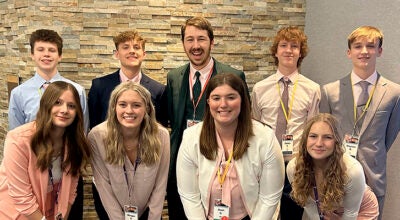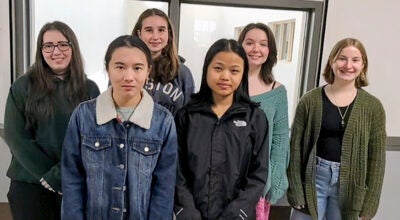Power through play: Mind, Body, Soul classroom at Banfield empowers students through playtime
Published 11:43 am Saturday, September 29, 2018
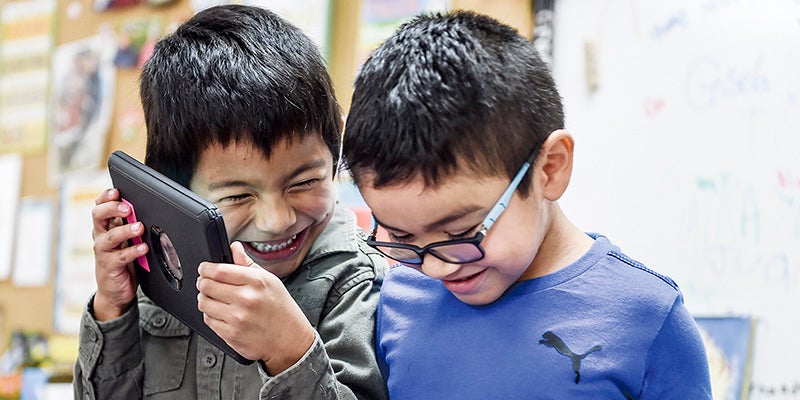
- Dennis Echeverria Garcia, left, and Martin Maldonado Basilo laugh as they listen to the sounds they recorded while using Spero Thursday afternoon. Eric Johnson/photodesk@austindailyherald.com
There’s a place at Banfield Elementary School where a kid can truly be a kid.
Inside Sue Conway’s classroom is a whimsical sanctuary for students to explore, to dream and to imagine endless possibilities through playtime.
Hanging from the ceilings were colorful mobiles and umbrellas, and scattered on the tables were an assortment of vintage toys that would peak the interest of young students to become inquisitive in how those toys worked. Amid the eye-catching interactive stations, eight students would be giggling amongst themselves as they played together.
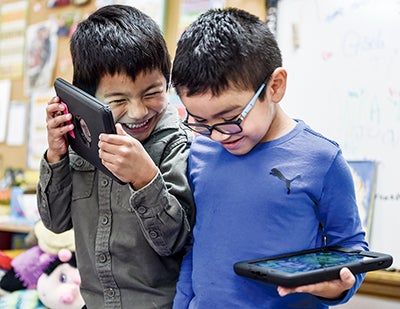
Dennis Echeverria Garcia, left, and Martin Maldonado Basilo laugh as they listen to the sounds they recorded while using Spero Thursday afternoon. Eric Johnson/photodesk@austindailyherald.com
Having been an educator for 36 years, Conway believes that through “ play” a child learns more about themselves as well as the world around them and believes that much of education has shifted away from child development and is focusing solely on academics as opposed to the “ whole child.”
“There is such value in play,” Conway said. “Students collaborate and work together and respect people’s ideas. They start building empathy and it ties into other life skills. Play is more than just fun, it is how we learn and grow.”
With that in mind, Conway had approached the district three years ago to implement a program with a curriculum she formulated herself. From that effort came the creation of the Mind Body Soul classroom, which allows a majority of Banfield students to spend 35 minutes a day every month for four weeks with Conway. They have opportunities to interact with eight stations—math, community, reading, STEM, science, technology, creativity and poetry—as part of Advance Academics and Talent Development, which engages children physically, emotionally and mentally.
“Play sparks imagination and builds character and strong bodies,” Conway said. “It sets the stage for lifelong health and learning.”
Whether it’d mean playing dress-up or figuring out how to operate robots, each station caters to a student and helping each individual figure out what they’re talented in, and apply what they learned into other classes.
“You do a lot of stuff that’s fun,” said Luke Christenson, a third grader playing with robots.
“Sometimes we learn about technology,” said Mikenaeh Borg, also a third grader. “We learn about many different things.”
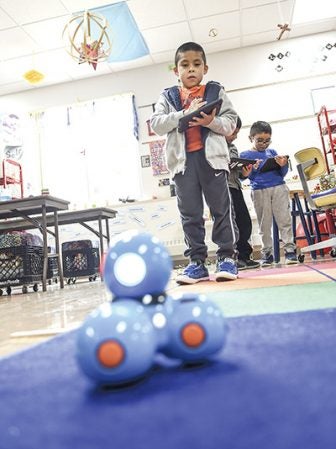
Alejandro Hernandez Maldonado guides a Spero robot during class Thursday at Banfield Elementary. Eric Johnson/photodesk@austindailyherald.com
For the span of the program, Conway sees about 80 students a day and meets with the more than all the “480-some” students who attend Banfield. By meeting the morning and afternoon group of students for those sessions, Conway quickly shuffles around to get activities set in place for the next round of children.
There’s no paperwork, she said, and there’s only hands-on activities.
“I’m a big ‘caring for the whole child’ teacher,” Conway explained. “I want them to be kind and respectful so they’re more well-rounded. Each child has talent. I feel frustrated that education has drifted way too far away from the childcare development curriculum and focus only on academics.”
One student, Conway recalled, had loved playing dress-up and started acting like characters. Eventually, Conway shared details with her mother about auditioning for roles at Matchbox Theatre. Conway learned that the student had been given a role and now loves acting in theatre.
“We’re hoping that it sparks an interest and they’ll pursue it further,” Conway said. “Play leads to greater things and exploration. I’m not sure she would’ve gone on if it weren’t for (the program).”
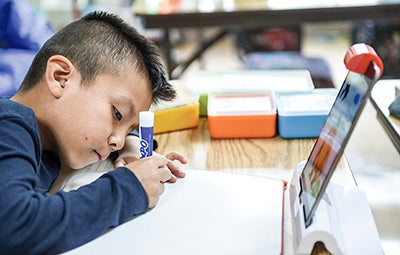
David Lopez Hernandez works with Ozmo Creative during class at Banfield Elementary Thursday. Eric Johnson/photodesk@austindailyherald.com
Connections to learning, play
There have been several studies that recognized the correlation between play and learning. According to the National Association for the Education of Young Children, guided play allows children to have additional focus when diving into classroom lessons through “exploration in context specifically designed to foster a learning goal.”
For Conway, who had been a teacher in the Austin Public Schools district for 31 years, believed that through “play” a child develops fully as well as curb behavioral issues in the classroom. From this program, Conway shared that there has yet to be a single office referral this year.
With that success in mind, Conway wants to continue opening her classroom for more children to come and “wonder.”
“Numerous kids feel successful and have this classroom to look forward to,” she said. “They’re gaining confidence.”
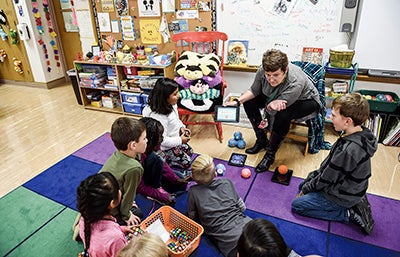
Banfield Elementary teacher Sue Conway explains to third graders how they can program Spero during class Thursday afternoon. Eric Johnson/photodesk@austindailyherald.com
By confidence, she felt that there was power in “yet.” When students express frustration that they believe that a task is too challenging, Conway empowers them to think of alternative solutions to overcome difficulties.
Something of which, she said, would contribute to a life skill.
“It’s the power of ‘yet,’” she said. “They can’t do it ‘yet’ and it give them hope. They learn lessons from ‘play’ to instill those values. It’s like what Albert Einstein says that I firmly believe, ‘Creativity is intelligence having fun.’”


